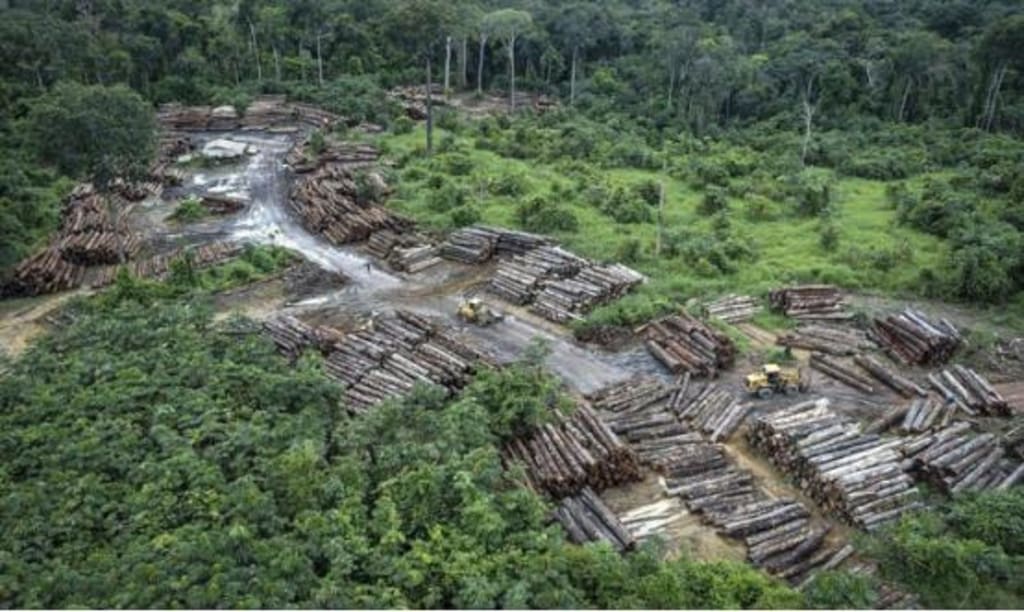After 100 years of disappearance, the "Wolverine" in the United States has reappeared. Why can extinct creatures be resurrected?
Why are extinct creatures still alive after 100 years of disappearance?

In the 19th century, after years of research, a great biologist proposed the survival law of all animals and plants in nature, that is, natural selection. We can also understand natural selection as "natural selection, survival of the fittest", and only species that adapt to environmental changes can stay in their original habitats. If a species cannot adapt to changes in the environment, they end up with only two outcomes, either extinction or migrating to other more suitable habitats.
There have been many extinction events in the biological history of the earth, and animal migration has been happening since ancient times. These are the results of natural selection. But after the emergence of human beings, especially after the development of civilization, the survival of natural creatures has added another layer of pressure, that is, the influence of human activities. There was once an animal known as "Wolverine" in the United States. It was once distributed in the north and south of the United States. Later, due to the influence of human activities, it gradually migrated to the north, and finally it was even confirmed to be extinct.
However, some time ago, the Seattle Times reported a piece of news that said that the American "Wolverine" has disappeared for hundreds of years since the beginning of the last century, and recently appeared in the Mount Rainier National Park in the United States, where "Wolverine" has disappeared. One of the regions where "Wolverine" originated. The news raised public questions about why long-lost species are reappearing? Is there really a "resurrection" in nature?
What kind of animal is the American "Wolverine"?
The real identity of the American "Wolverine" is the wolverine, because it looks like a combination of a mink and a bear, so people call it "sable bear". Adult mink bears weigh 8 to 25 kilograms, reach 80 to 100 centimeters in length, and have tan fur. Most mink bears prefer to travel alone, and they usually rest during the day and then go out foraging at night. Mink bears have a mixed diet, eating not only ungulates and rodents, but also forest berries, etc., and even foxes and wild cats.
Mink bears are now only distributed in the arctic edge and sub-Arctic regions. In my country, there are only two regions in the Northeast Daxingan Mountains and Xinjiang Altai Mountains where there are mink bears, but the total number of mink bears in these two areas does not exceed 400, so this The species has long been listed as a national first-class protected animal. Studies have shown that the origin of sable bears is the northern region of the United States. For example, in the Mount Rainier National Park mentioned at the beginning of the article, the sable bear population has spread from the north to the south.
The Seattle Times pointed out that mink bears were common in the United States a few hundred years ago, but people have seen less and less of them in the wild since then. According to the statistics provided by U.S. National Parks, there are still 300 to 1,000 mink bears in the United States at this stage, but they are almost all distributed in the south. The mink bears in the northern region have disappeared since the beginning of the last century, so this time the northern The appearance of sable bears has attracted the attention of many wildlife biologists.
Why is the population distribution of sable bears retreating north?
Mink bears were originally only distributed in the northern regions of the United States. In order to obtain more chances for survival, some mink bears migrated south. According to fossil records, the furthest mink bears migrated to California, Utah and Colorado. Mink bears that migrated to the south began to adapt to the local climate and gradually gained a firm foothold. However, the mink bears that still live in the north have been killed by humans due to the destruction of their habitats.
According to the scientific report, scientists have found traces of mink bears in the northern region again after a hundred years. There are two possibilities for this situation. First, the mink bears in the north have never become extinct, and they are just undiscovered by humans because of their very small numbers; Second, the mink bears in the south migrated to the north to live. Most researchers lean toward the second possibility, arguing that southern marten bears may have "returned to their place of origin," a phenomenon that has historically occurred in other species.
So what caused the mink bears that lived well in the south to migrate back to the north again? Because their survival in the South has become difficult, the reason behind it is likely that the habitat has been greatly damaged. Mink bears originally lived in the cold coniferous forest, they migrated to the warm and humid climate in the south and began to adapt to the environment of the broad-leaved forest. Therefore, it is not difficult to infer that the broad-leaved forests where the mink bears exist in the southern United States have been destroyed by human and natural activities.
What human activities can cause damage to the habitat of mink bears? It is possible to develop forests and raze patches of forest to the ground. It is also possible that human industrial production activities have affected changes in the natural climate, which in turn affects the development of forests. For example, climate warming leads to an increase in the probability of extreme weather, which will seriously affect the climate environment in a local area, and then affect the biological environment in the area. . All in all, the northward migration of mink bears is likely the result of habitat destruction.
Are sable bears really "resurrected from the dead"?
In fact, the statement that "the mink bear 'resurrected from the dead'" is not rigorous, because as long as there are mink bears in other parts of the earth, then the species is not extinct. As for the re-emergence of mink bears in the northern United States, scientists think both possibilities indicate that they never went extinct. The first possibility is that its population size has shrunk sharply, and then remained at extremely low numbers for a long time. The second possibility is that the southern mink bears migrated to the north, and there is not much difference in the appearance of the mink bears in the two regions.
In recent years, there have been many cases of "disappeared or extinct animals 'resurrected'" in the news media, but the species in all cases have never gone extinct, they just avoided the doom of extinction, because the truly extinct species Species cannot be resurrected again under natural conditions. But there is one species that is incredible. It is the white-throated rail chicken that disappeared with the sinking of the island 130,000 years ago, and then reappeared with the rise of the island.
The white-throated rail is the last remaining bird with no flight ability in the western part of the Indian Ocean. Its body is relatively slender and its feathers are brighter in color. Because of the pinch of white feathers growing out of its throat, it is called "" diphtheria rails". Except for the white feathers of the throat, the rest of the plumage of the diphtheria rail is basically black and brown. Initially, scientists discovered a bizarre phenomenon while studying the bird on an island in the western Indian Ocean.
Di-throated rail chickens originally came from the African continent. They should have flown to this island as early as hundreds of thousands of years ago to seek a chance to survive. It turned out that there is not only abundant food on this island, but also no natural enemies. Such a comfortable life makes them Slowly lost the ability to fly. This incapacity to fly seems to us to be "inactive", so nature punished them 130,000 years ago, many islands in the western Indian Ocean were submerged by sea water, and all the white-throated rails on the island were absent. spared.
After 30,000 years, the once submerged island surfaced again. Strange things happened. Less than 10,000 years after the island appeared, diphtheria rails appeared on it. What happened? Did the diphtheria rails come back to life? In fact, it is not. Scientists say that the diphtheria rails on the African continent have undergone repeated evolution, that is, the diphtheria rails that were originally able to fly flew to the islands to live, but lost their ability to fly after a period of time. They are the diphtherias we see now. Crawfish.
Is the sixth mass extinction event really happening quietly?
Therefore, strictly speaking, the diphtheria rail is not "resurrected from the dead". There is no species in nature that can "resurrect from the dead". The remains of extinct creatures are either buried underground or placed in museums. exhibition. When it comes to biological extinction, we have to talk about one of the most famous predictions in the 21st century-the sixth mass extinction event is quietly staged. This is a prediction made by many scientists through long-term research and analysis, which has aroused the concern of many people.
The sixth mass extinction event is also known as the "Holocene extinction event" because historians define this period of human emergence as the "Holocene." The event is defined as a global widespread and long-lasting biological extinction event involving animals and plants, most of which occurred in tropical and subtropical regions. Since the Industrial Revolution, human beings have only seen the practical value of natural organisms, ignoring their ecological value, and have arbitrarily exploited them.
The consequence of these actions is that over the past 200 million years, an average of 90 vertebrate species have gone extinct every 100 years, and an average of one higher plant has gone extinct every 27 years. The industrial revolution has accelerated the rate of species extinction, and some scientists predict that 2 million species will actually go extinct in the 21st century. The extinction of so many organisms is bound to have a huge impact on the ecological environment and ecological balance, and then affect the survival of human beings.
How should humans prevent the Holocene mass extinction?
Although human society is conceptually separated from nature, in fact human society cannot do without the support of nature. Once a major accident occurs in nature, it will definitely affect human society. . So how can we prevent the Holocene mass extinction from happening? The top priority is to deal with the deterioration of the climate and environment. Climate warming is a long-standing and difficult problem. All countries need to reach a consensus on this aspect, and everyone on the earth needs to reach a consensus.
The second is to establish species gene banks. At present, some international scientific institutions have established seed banks in polar regions, which store the seeds of most plants on the earth. But this is not enough. Humans also need to put animal genes into it, in case there is a major change in the earth's ecology one day, there is still a glimmer of hope for human beings.
About the Creator
Vicky
The world is so wonderful, let's get to know the world together!
Enjoyed the story? Support the Creator.
Subscribe for free to receive all their stories in your feed. You could also pledge your support or give them a one-off tip, letting them know you appreciate their work.






Comments
There are no comments for this story
Be the first to respond and start the conversation.